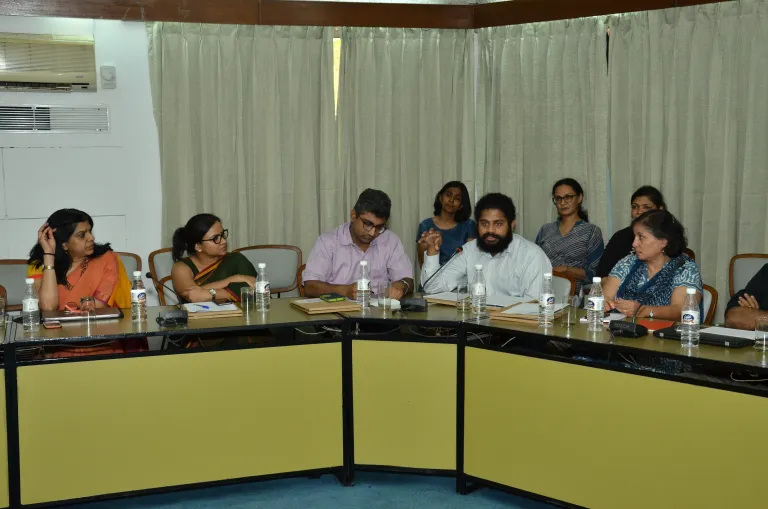“Ultimately, transportation is the fulcrum that allows women to participate in the workforce; a societal shift to transform the entire world economy.” – Sonal Shah, Senior Manager, ITDP India Programme Centred around this idea, ITDP and Safetipin have released a policy brief on Women and Transport in Indian Cities. The draft was released on 13 June 2017 at a roundtable discussion on Gender and Transit, organized by ITDP, Safetipin and UN Women with participation from 30 women’s groups, international organizations, professionals and academic institutions.
Writer unknown

A roundtable discussion on Gender and Transit was organized by ITDP, Safetipin and UN Women with participation from 30 women’s groups, international organizations, professionals and academic institutions
The coming decade will be a defining moment for India as its urban areas are estimated to constitute around 40 per cent or 600 million of its total population by 2030. According to the High Powered Executive Committee (HPEC), around INR 23 lakh crores is required over 2015–2030 for India’s urban transport infrastructure. The national government has initiated missions and schemes to invest in urban transport and infrastructure; and created indicators and service level benchmarks to establish a city’s baseline and goal for improvement. The recently announced Green Urban Mobility Scheme (GUMS) expects to invest around INR 70,000 crores over 2018–2023 on sustainable transport.
“The defining characteristic of violence against women is its normalization and ordinary and continuous nature.” – Kalpana Viswanath, Co-founder & CEO, Safetipin
While there is momentum by different levels of government in addressing women’s safety in public transport, urban transport investments are largely gender blind with a limited understanding of the interrelationships between gender and transport. Sustainable urban development will remain elusive without integrating women and girls in urban transport.
Women and girls are close to 50 per cent of our urban population. They comprise only 19 per cent of “other workers”, 84 per cent of their trips are by public, intermediate public and non-motorized modes of transport (Census 2011)[2]. While 73 per cent of trips by “other workers” in urban areas are by sustainable modes of transport, women and girls’ share is only 14 per cent. Ultimately transportation will help women access economic and social opportunities. In the next few years, cities will need to make a concerted effort to improve women and girls’ experience of sustainable modes of transport to achieve a target of 40 per cent of all trips. The policy brief fills this gap by providing a framework to integrate technical and social, quantitative and qualitative approaches for enabling this transition.
In Section 1, the brief underscores the need for a policy brief focusing on women and transport in Indian cities. Section 2 describes the scope of the brief. The gendered dimensions of urban transport are covered in Section 3, with a focus on trip chaining and purpose, modal shares, trip distances, time poverty, sexual harassment and employment in the transport sector. Section 4 proposes urban transport indicators and service level benchmarks for comprehensive mobility plans. Recommendations to improve women’s modal shares and experiences of walking, cycling, public and intermediate public transport, and engendering public transport authorities, are highlighted in Section 5. Since urban transport is not the responsibility of one ministry or department, gender inclusion will require interventions at multiple scales and coordination with a number of ministries and departments. Section 6 identifies such ministries and departments and their potential role in mainstreaming gender.
Women’s access and use of urban transportation will play a key role in achieving India’s sustainable development goals (SDGs) and ensure women’s right to the city and its public spaces. To quote Shreya Gadepalli, who leads the ITDP India Programme, “When we create cities – their public spaces and transport systems – that are responsive to the needs of women, children and the elderly, they become great cities for all!”
Download the policy brief here.
- List of organisations that participated in the roundtable: Akshara Centre, Asian Development Bank, Azad Foundation, Breakthrough, Centre for Urban Equity (CUE), Confederate of Indian Industry (CII), Columbia Global Centre, Cornell University, CORO, Centre for Policy Research (CPR), Centre for Road Research Institute in India (CRRI), Centre for Women and Development Studies (CWDS), Delhi University, DIMTS, Hindustan Times, iTrans, Jagori, Janki Devi Memorial College (JDMC), KfW, Manas Foundation, Oak foundation, Oasis Design, Observer Research Foundation (ORF), Plan India, Sushant School of Art and Architecture, Ansal University, Tata Institute for Social Sciences (TISS), Toji Communication Consultancy, TRIPP-IIT Delhi, UBER, UITP, UNDP, UNICEF, World Bank, World Resources Institute (WRI)
- This data is likely to under represent women and girls’ mobility as their care trips are not measured.
